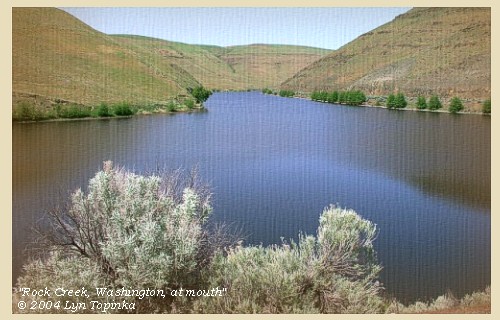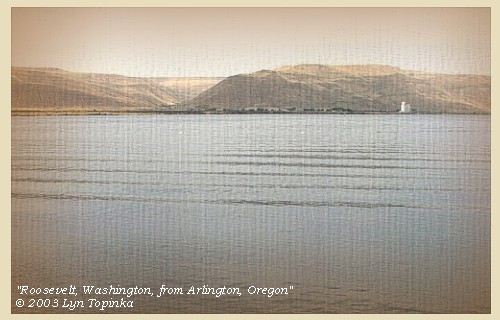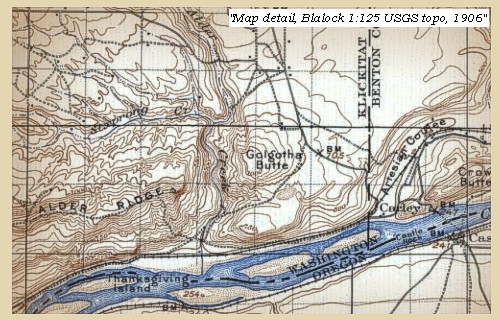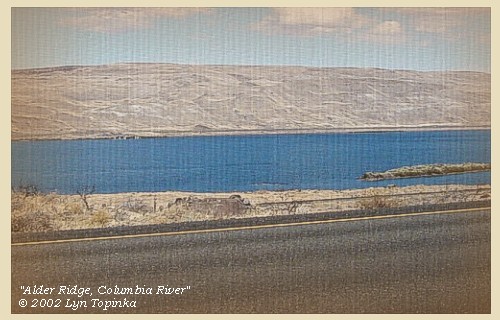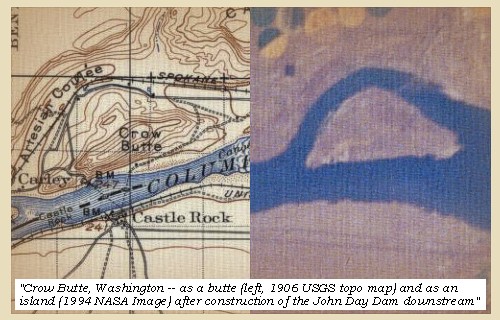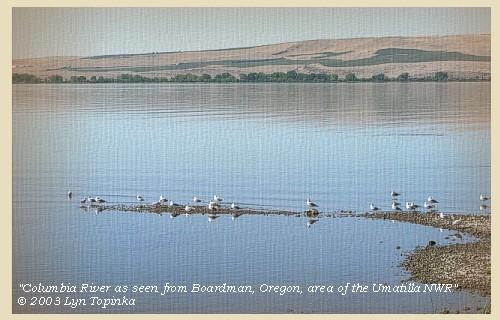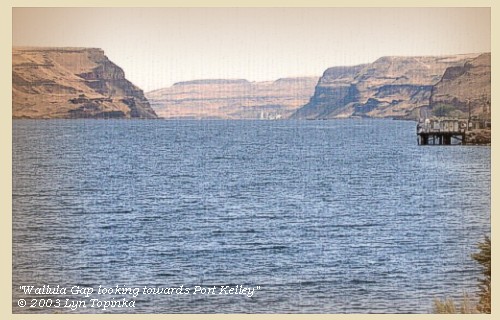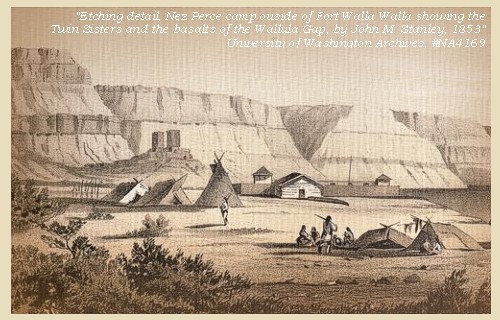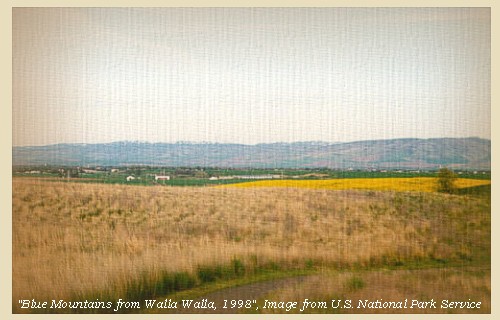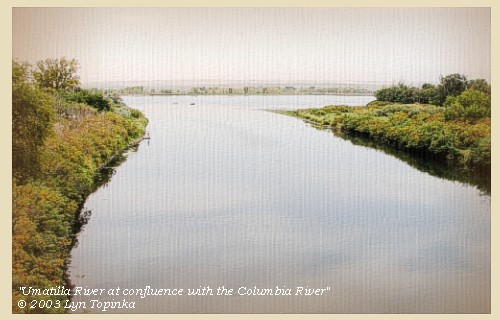
Umatilla River:
The Umatilla River originates on the west slope of the
Blue Mountains, east of Pendleton, Oregon. It flows
115 miles north and west to enter the Columbia
River at River Mile (RM) 289, draining an area of nearly 2,290 square miles.
The mouth of the Umatilla River is at approximately 270 feet elevation above
mean sea level. The headwaters are as high as
4,950 feet.
The south and east portions
of the Umatilla drainage lie on the steep,
timbered slopes of the Blue Mountains
within the Umatilla National Forest. The remainder
of the drainage consists of moderate slopes and level terrain.
Lewis and Clark called the river "You ma lolam River". They missed the river in 1805, but added it to the route maps on the return trip in 1806.
The river's name was standardized when Wilkes charted it in 1841. Umatilla Landing was established at the mouth of the river in 1863, an important steamboat landing on the Columbia for mines in Oregon and Idaho.
White River
--
Bonneville Power Administration Website, 2002,
Columbia Basin Fish and Wildlife Authority Website, 2004,
and
Washington State Historical Society Website, 2004, "Lasting Legacy".














- 1814 Map, Lewis and Clark's map of the Columbia River (section of original). (Click to enlarge.) Shows the Umatilla River ("You-ma-lolam R.").
Map also includes three of the five volcanoes Lewis and Clark saw and commented on. While the journals mention the expedition seeing Mount Adams, it does not appear on their map. Mount Jefferson is just visible to the south (bottom) and Mount Rainier is to the north but off the map.
From the "Nicholas Biddle/Paul Allen" 1814 publication.
Original Map: "A Map of Lewis and Clark's Track, Across the Western Portion of North America, From the Mississippi to the Pacific Ocean".
From: History of the expedition under the command of Captains Lewis and Clark : to the sources of the Missouri, thence across the Rocky Mountains and down the river Columbia to the Pacific Ocean : performed during the years 1804-5-6 : by order of the government of the United States / prepared for the press by Paul Allen. Philadelphia : Bradford and Insskeep, 1814.
Harold B. Lee Library, Brigham Young University #upbover maps37.
-- Brigham Young University, Harold B. Lee Library Website, 2004.
- 1837 Map, Columbia River with Mount Hood (section of original). (Click to enlarge).
Includes the Umatilla River ("Ottalais R.").
Original Map: Map of the Territory West of the Rocky Mountains (1837)
Author: Washington Irving, Publisher: Philadelphia, Carey, Lea, & Blanchard.
Washington State University Archives #WSU555.
-- Washington State University Early Washington Maps Digital Collection Website, 2004
- 1853 Map, Washington and Oregon and the Columbia River,
from the Clearwater River to the Snake River and down the Columbia River to the Pacific Ocean (section of original). (Click to enlarge).
Includes: Clearwater River (Kooskooski), Lapwai Creek (Lapwai R.), Snake River (Saptin or Lewis R.), Columbia River (Columbia R.), Yakima River (Yakima R.), Walla Walla River (Wallawalla R.), Umatilla River (Umatilla R.), Willow Creek (Quesnells R.), John Day River (John day's R.), Deschutes River (Fall R.), Willamette River (Willammette R.), and Cowlitz River (Cowlitz R.).
Original Map: "Map of California, Oregon, Washington, Utah, and New Mexico (1853)",
by Thomas Cowperthwait & Co.
Washington State University Archives #WSU22.
-- Washington State University Library Collections Website, 2003
- 1853-54 Map, Columbia River, including the Wallula Gap area (section of original). (Click to enlarge).
Includes Horse Heaven Hills ("lands destitute of timber"), Willow Creek, Umatilla River, Walla Walla River, Touchet River,
Twin Sisters ("Chimney Rock"), Yakima River, and the junction of the Snake River (only the "S" shows) with the Columbia.
Original Map: "Rocky Mountains to Puget Sound : from explorations and surveys / made under the direction of the Hon. Jefferson Davis, Secretary of War by Isaac I. Stevens Governor of Washington Territory, 1853-4."
Inset: (Supplementary sketch) Reconnaissance of the railroad route from Wallawalla to Seattle via Yak-e-mah River & Snoqualmie Pass. By A. W. Tinkham in January 1854. Drawn by J. R. P. Mechlin. 20 x 28 cm.
Topographer, John Lambert, Published in Washington D.C., 1859, 1:1,200,000, Notes: From the U.S. War Department, Explorations and Surveys for a Railroad Route from the Mississippi River to the Pacific Ocean, Topographical Maps, to Illustrate the Various Reports, U.S. Library of Congress American Memories Reference "LC Railroad Maps #156".
-- U.S. Library of Congress, American Memories Website, 2004
- 1855 Map, Clearwater and Snake Rivers, including the
Umatilla River (U-mah-ti-lah R.) (section of original). (Click to enlarge).
Original Map: "Map of Oregon and Washington Territories:
showing the proposed Northern Railroad route to the Pacific Ocean,
by John Disturnell, 1855.
University of Washington Archives #UW155.
-- University of Washington Library Collections Website, 2002
- 1858 Military Recon Map (section of original),
Mouth of the Umatilla River. (Click to enlarge).
Map of military reconnaissance from Fort Dalles,
Oregon, via Fort Wallah-Wallah, to Fort Taylor, Washington Territory,
1858. Shows approximate location of military road
constructed 1859 to 1862. From the report and maps of
Captain John Mullan, United States Army, G.P.O., 1863.
University of Washington Archives #UW85.
-- University of Washington Library Archives Website, 2002
- 1863 Map (section of original), Columbia River,
Umatilla Rapids, Monumental Rocks, Umatilla River,
Walla Walla River, Touchet River, etc. (Click to
enlarge).
Original map by John Mullan, Julius Bien, and
Edward Freyhold, United State Office of Explorations and Surveys.
Prepared from field notes from 1858-1863.
Scale 1:1,000,000.
Original map from:
report and maps of Captain John Mullan, United States Army,
of his operations while engaged in the construction of a
military road from Fort Walla-Walla, on the Columbia River,
to Fort Benton, on the Missouri River, 1863.
-- University of Washington Library Archives Website, 2002
- 1908 Map, mouth of the Umatilla River (section of original), from Umatilla 1:125,000 topographic quadrangle. (Click to enlarge).
Original map surveyed in 1907, contour interval of 50 feet.
What is marked "Devils Bend Rapids" on this topo map corresponds
to "Umatilla Rapids" on the 1858 and 1863 maps.
The 1858 and 1863 "Umatilla Rapids" are downstream of the mouth of the Umatilla River.
-- University of Washington Library Collections Website, 2002
- 1984 Map, Umatilla River, Umatilla, and McNary Dam (section of original). (Click to enlarge).
Office of Coast Surveys, Historical Maps and Charts,
Columbia River, Blalock Islands to McNary Dam, 1984, Chart#18539, 1:20,000.
-- NOAA Office of Coast Survey Website, 2004
- 1985, NASA Image, Columbia River from Willow Creek to McNary Dam
(section of original) (Click to enlarge).
View from space - Columbia River, Willow Creek, Alder Creek, Crow Butte, Umatilla National Wildlife Refuge vicinity,
Umatilla River, McNary Dam, and Lake Umatilla,
August, 1985. The Columbia River flows right (east) to left (west).
Washington State is the upper half of the image (north) and Oregon is the lower half (south).
Lake Umatilla was formed by the John Day dam (not in image).
NASA Earth from Space #STS51F-035-0011.
-- NASA Earth from Space Website, 2002
- 1985, NASA Image, Closer-in view Columbia River and the
Umatilla National Wildlife Refuge vicinity
(section of original) (Click to enlarge).
View from space - Columbia River, Crow Butte, Lake Umatilla, and the Umatilla National Wildlife Refuge vicinity,
August, 1985. The Columbia River flows right (east) to left (west).
Washington State is the upper half of the image (north) and Oregon is the lower half (south).
Lake Umatilla was formed by the John Day dam (not in image).
NASA Earth from Space #STS51F-035-0011.
-- NASA Earth from Space Website, 2002
- 1994, NASA Image, Columbia River from Crow Butte to the Snake River
(section of original) (Click to enlarge).
View from space - Columbia River, Snake River, Yakima River, Walla Walla River, Umatilla River,
Crow Butte and Wallula Gap,
north-looking, low-oblique photograph, September 1994.
NASA Earth from Space #STS064-112-093.
-- NASA Earth from Space Website, 2002
- 1994, NASA Image, Columbia River, including the Umatilla River
(section of original) (Click to enlarge).
View from space - Columbia River, McNary Dam, Umatilla River, Sillusi Butte vicinity, Juniper Canyon, and Spring Gulch,
north-looking, low-oblique photograph, September 1994.
NASA Earth from Space #STS064-112-093.
-- NASA Earth from Space Website, 2002
- 2003, Umatilla River, Oregon, at its confluence with the Columbia River.
(Click to enlarge).
Copyright © 2003 Lyn Topinka, private archives, used with permission.
|


